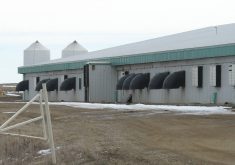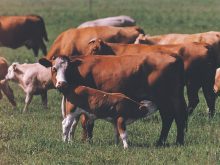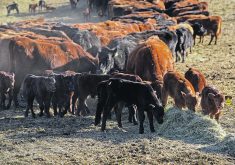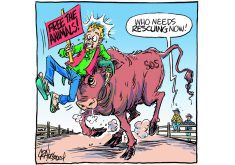When an animal dies on pasture, it is often classified as a sudden death because it was not seen ill. There are many reasons for sudden death, and though it is the loss of only one animal, it could signal the start of an outbreak. This is why the reason for the demise must be determined.
Sudden death is not a diagnosis. The death is investigated by performing a post-mortem. Just like any other cause of illness and death, the reasons are categorized into nutritional, infectious, toxic and other.
Read Also

Budget seen as fairly solid, but worrying cracks appear
The reaction from the agriculture industry to prime minister Mark Carney’s first budget handed down November 4th has been largely positive.
Bloat is the most common nutritional disease. Certain proteins in forages promote froth formation in the rumen. The froth prevents eructation, more commonly known as belching, and gas accumulates.
The gas-filled rumen enlarges so much that it impairs blood circulation to the heart and makes breathing impossible. Bloated animals can be spotted by characteristic rumen distension high in the left flank. Immediate treatment is needed to prevent death.
On pasture, bloat is usually blamed on legume consumption. Early spring pastures in the pre-bloom stage are particularly risky because plants contain high concentrations of bloat-producing proteins. Cattle released on new pastures should be observed periodically over the first few days for any signs of bloat. If there is a risk, controlling grazing and providing anti-foaming medication help prevent the disease.
Grass tetany is another nutritional disease. Seen normally in the spring on fast-growing forages, it is due to a deficiency of magnesium. Grass tetany can cause muscle tremors and convulsions and lead to sudden death. Magnesium injections, given early enough, can reverse the symptoms.
Selenium-deficient forages can cause white muscle disease. Seen in young, growing cattle, this deficiency triggers muscle damage in the heart that can lead to abrupt death. In milder cases, the animal may just be weak from the diseased muscles. Selenium supplements can prevent the disease.
Many infections are responsible for sudden death in cattle and most of them come from the soil. For example, anthrax causes a severe blood infection with few, if any, signs of illness before death. It is seen when animals ingest dormant spores from the soil. These spores appear when soil is disturbed by changes in rainfall or drought. Once soil is contaminated with spores, the disease tends to repeatedly recur in that place. Spores have been known to last up to 100 years.
Clostridial infections are another group of diseases caused by spores in the soil. Once blackleg spores are consumed, they move through the bloodstream to muscle tissue. They stay dormant, but if the muscle is later traumatized, the damaged muscle is a breeding ground for the bacteria. Their multiplication causes severe inflammation, toxin production and death. Cattle with blackleg may be seen limping or moving stiffly, but more commonly they are found dead.
Malignant edema is another clostridial disease. The bacteria invade the body through a wound and multiply in that area, causing swelling, fever and death within 24 to 48 hours. Vaccines are available against clostridial diseases as well as anthrax.
Many toxins on pasture can cause death, with the metal lead being the most common. Inquisitive young animals are most likely to be poisoned and death is often the first symptom seen. The concern with lead is that it can become a herd problem and other calves will develop symptoms if their access to the lead is not prevented.
Toxins are also contained in plants. Some, such as arrow grass and sorghum, concentrate cyanide, while others accumulate nitrates, especially after a frost. Toxins in blue-green algae blooms can kill within minutes after drinking contaminated water. Diagnosing these poisonings depends on finding the plants or their toxins in the rumen. Prevention means producers must be aware of what plants are potentially poisonous and how to eradicate the threat.
Lightning strike belongs in the other category. It is a concern in late summer when thunderstorms occur. In some strikes, burn marks are evident on the hair and on nearby trees and fence posts. One strike can kill several animals. Prevention is difficult.
The best way to determine the cause of sudden death is for a veterinarian to examine the dead animal. A physical examination may be enough, but in other cases tissue samples or stomach contents may need to be sent away for analysis. An examination is critical if an insurance claim is being made for a lightning strike.














